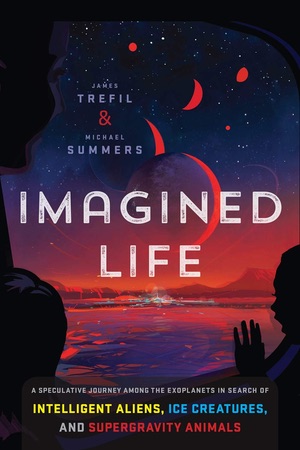Review: Imagined Lifeby Jeff Foust
|
| A tidally locked world might have silicate snowflakes from rocks vaporized in the sun-facing side that precipitate out after reaching the other hemisphere. Yet, it could have liquid water in that narrow transition zone, and also support life beneath its surface. |
At the same time, though, what constitutes a “habitable” world has also been changing, thanks to both growing knowledge of extremophile life on Earth that thrives in conditions that seem utterly inhospitable, as well as studies of other worlds in our solar system. Both Europa and Enceladus appear to have subsurface oceans of liquid water and organic compounds, while Titan has hydrocarbon seas. Mars, of course, continues to tantalize as a potential past or present abode of life with evidence of liquid water on its surface early in its history and below it today.
What’s increasing clear is that, given that diversity of life on Earth and variety of other worlds, any life that exists beyond Earth may not be much like what we’re used to. That’s the theme of Imagined Life, a speculative romp by two scientists that examines what life might be life on worlds very different from Earth.
Trefil and Summers, a physicist and planetary scientist, respectively, at George Mason University, spend the first few chapters providing an overview of the science of life beyond Earth, from astronomy to biology. The fun really begins, though, when they examine a range of hypothetical worlds and their ability to support life. Some have subsurface oceans of liquid water covered by ice, while others are entirely water worlds with no land on its surface. They also explore super-Earths several times the mass of the Earth and planets that are tidally locked with only a narrow area along the terminator where temperatures are neither scorching nor freezing.
The life—including intelligence—that these worlds could harbor is, of course, quite different from the life here on Earth. On an icy world with the only liquid water found near hydrothermal vents, life could thrive but would see in the infrared and, if it became advanced, would consider the pipe a technology as vital as the wheel is to our own. The tidally locked world might have silicate snowflakes from rocks vaporized in the sun-facing side that precipitate out after reaching the other hemisphere. Yet, it could have liquid water in that narrow transition zone, and also support life beneath its surface.
As the subtitle notes, this analysis is a speculative one: a possible set of worlds where life, under a certain set of assumptions, could emerge and evolve. Different worlds and different assumptions could lead to very different results, including no life at all. But we are now just in the early phases of astrobiology, still learning what we don’t know about other worlds and the formation of life. The book, though, helps stress the point that life might well be commonplace in the universe, but if it is it’s likely not like the common life we see here on Earth.
Note: we are temporarily moderating all comments subcommitted to deal with a surge in spam.
